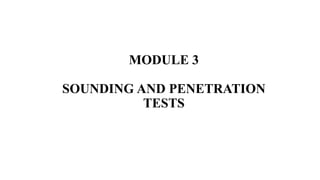This document provides information on three common penetration tests: Standard Penetration Test (SPT), Static Cone Penetration Test (SCPT), and Dynamic Cone Penetration Test (DCPT). It describes the procedures, equipment, corrections, and correlations with engineering properties for each test. The SPT is the most commonly used test and provides data on density and strength. The SCPT gives continuous resistance measurements with depth. The DCPT is fast and inexpensive but resistance values must be correlated to SPT results. Each test has advantages and limitations depending on the soil type and project needs.














































